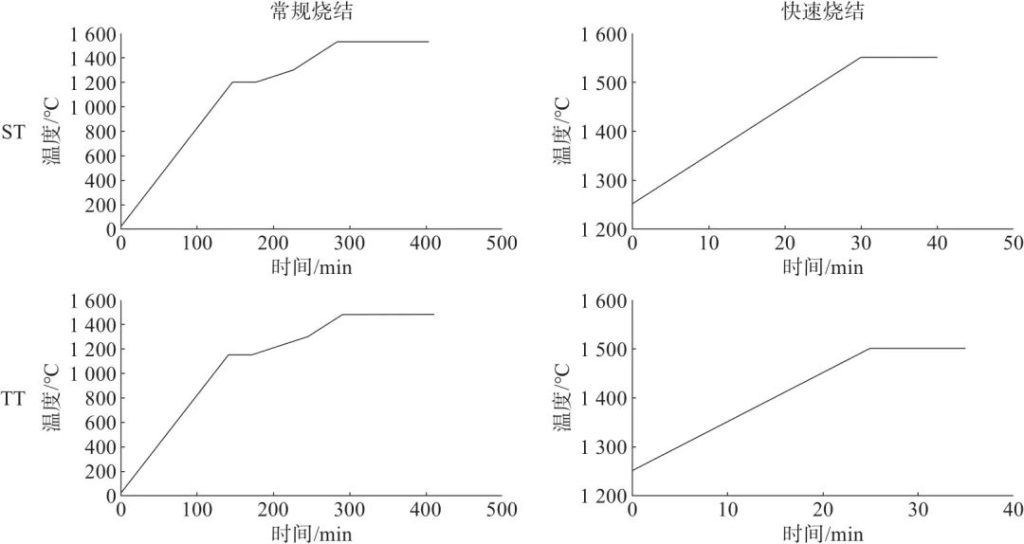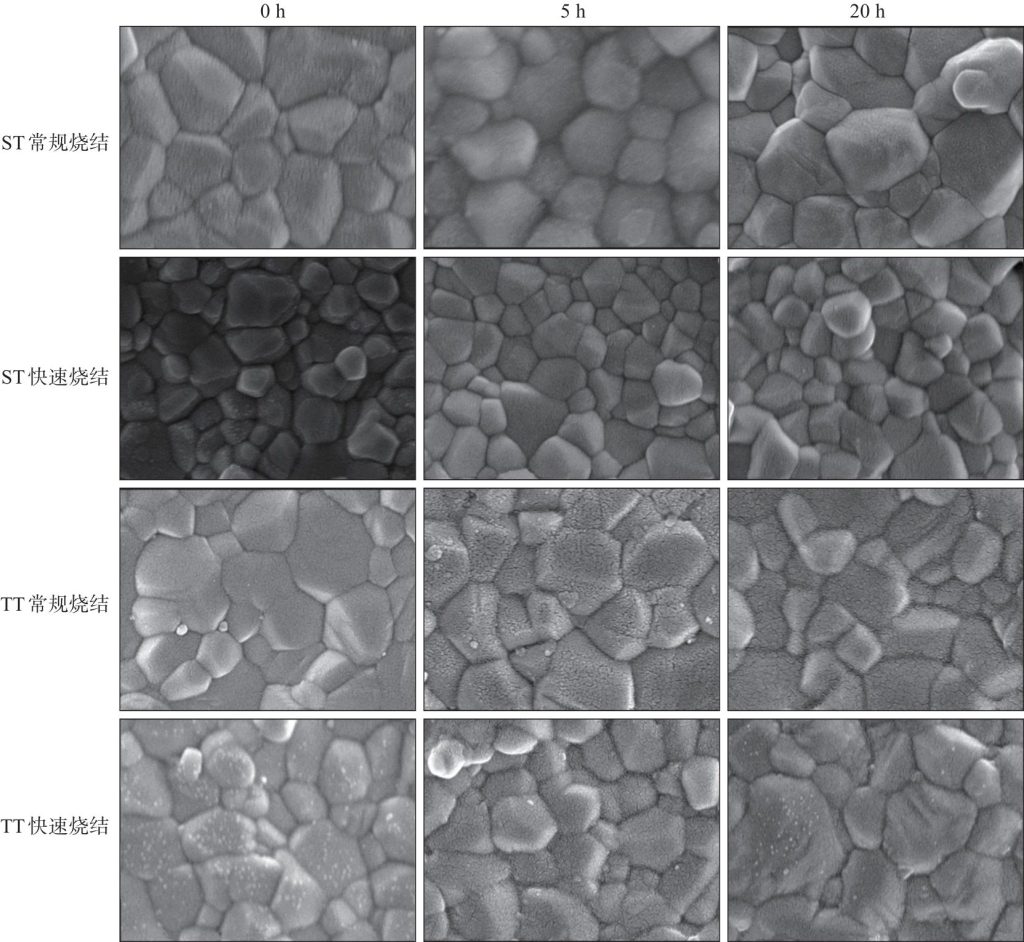Zirconia has excellent mechanical properties and good biocompatibility, but it is difficult to achieve aesthetic characteristics comparable to natural teeth. The introduction of highly transparent zirconia and ultra-transparent zirconia meets the demand for full zirconium crown repair in the aesthetic area, but the long-term sintering of zirconia limits its use in one-time chairside repairs. The low-temperature aging of zirconium oxide in the mouth has always been a concern. Therefore, the purpose of this study is to use high-strength zirconia as a control group to study the effects of rapid sintering and low-temperature aging on the semipermeability of high-strength zirconia.
1.1 Experimental materials and instruments
A2 color high-strength zirconia ST-ML (ZrO2+HfO2+Y2O3>97.7%, Y2O3: 4%~5%; hereinafter abbreviated as ST) and A2 color high-permeability zirconia TT-ML (ZrO2+HfO2+Y2O3>96.5% , Y2O3: 5.8%~9.7%; hereinafter abbreviated as TT) (Shenzhen Altron Technology Co., Ltd.), Shade Eye NCC colorimeter (SH-OFU Company, Japan), X-MILL 500 five-axis linkage engraving and milling machine (Shenzhen Xiangtong Optoelectronics Technology Co., Ltd.), Up Fire C1 sintering furnace (Shenzhen Altron Technology Co., Ltd.), digital micrometer (HOLEX Company, Germany), VGT-1200 ultrasonic oscillator (Guangdong Good Ultrasound Co., Ltd. Company), Regulus 8100 cold field emission scanning electron microscope (SEM) (Hitachi, Japan), JFL-1600 gold spray instrument (Nihon Electronics Corporation, Japan).
1.2 Test piece production
A2 color high-strength zirconia ST and high-permeability zirconia TT were selected and cut into square sheets with a side length of 10 mm and a thickness of 1.5 mm using CAD/CAM technology according to a 20% sintering ratio, 60 pieces each, for a total of 120 specimens.
1.3 Sintering and grouping of specimens
The cut ST and TT were randomly divided into two groups for conventional sintering and rapid sintering. The sintering temperature for conventional sintering of ST was 1530 ℃ and the insulation was kept for 2 h. The sintering temperature of the conventional sintering of TT was 1480 ℃ and the insulation was kept for 2 h; ST The sintering temperature of rapid sintering is 1550 ℃ and the heat preservation is 10 min. The sintering temperature of TT rapid sintering is 1500 ℃ and the heat preservation is 10 min. The sintering curve is shown in Figure 1. All sintering is completed using the Up Fire C1 sintering furnace. The sintered zirconium blocks are flat and smooth square sheets. The specimens that do not meet the thickness are discarded and remade so that the final thickness of all specimens is (1.5±0.02) mm. Then, the zirconia specimen was placed in distilled water using an ultrasonic oscillator for 10 min, and then dried naturally for 24 h.

1.4 Low temperature aging of specimens
The sintered specimens were randomly divided into 3 subgroups, with 10 specimens in each group, and were placed in a high-pressure accelerated life chamber under the conditions of 134°C and 0.2 MPa for simulated low-temperature aging for 0, 5, and 20 h respectively.
1.5 Statistical analysis
All data were analyzed statistically using SPSS 25.0, and measurement data were described as mean ± standard deviation. Shapiro-Wilk was used to test the normality of the data, and Levene's homogeneity of variance test was used to determine equal variances. If the data satisfies normality and homogeneity of variance, a two-factor variance analysis will be used to analyze the effects of sintering method and low-temperature aging on the semipermeability of highly permeable zirconia. When the results show that the difference is statistically significant, Bonferroni will be used to conduct pairwise comparisons and analyze separately. The influence of sintering method and low-temperature aging on the semipermeability of highly permeable zirconia; if normal distribution and homogeneity of variances are not satisfied, non-parametric tests will be used for statistical analysis. All statistical analyzes were two-sided tests, the test level was α=0.05, and P<0.05 was used as a significant difference mark.
For ST, the sintering method has a significant impact on the TP value, and the TP value decreases significantly after rapid sintering. Low-temperature aging has a significant impact on the TP value of conventional sintered ST. As the aging time prolongs, the TP value decreases significantly, but the TP value of fast-sintered ST does not change significantly as the aging time prolongs (Table 1). For TT, the TP value after rapid sintering is higher than that of conventional sintering, but regardless of the sintering method, low-temperature aging has no effect on the TP value of TT (Table 2).
ST’s TP value and statistical significance

TP value of TT and statistical significance

The SEM results of each group are shown in Figure 2. The grain size of ST rapid sintering is significantly smaller than that of conventional sintering, and there is no obvious difference between the grain size of TT rapid sintering and conventional sintering. After low-temperature aging, microcracks and grain eruption appeared in all groups, and they gradually increased with the prolongation of aging time. After aging for 20 h, obvious grain eruption and micro-cracks appeared on the surface, especially the conventionally sintered ST.

The ST and TT used in this study are the second and third generation zirconia, respectively. The second generation zirconia, also known as high-strength zirconia, is made by reducing the concentration of alumina (<0.05%) and sintering at a higher temperature than the first generation zirconia. Its translucency is improved, its mechanical properties are good, and its bending strength can reach 900~1300 MPa. It can be used for the restoration of full zirconium crowns in the posterior area where aesthetic requirements are not high. High-translucency zirconia increases the content of the stabilizer yttria, which increases the content of the cubic phase in the zirconia after the final sintering. It has a dual-phase microstructure composed of tetragonal zirconia crystals and cubic zirconia crystals [1], which further improves the translucency of zirconia and can be used for the restoration of full zirconium crowns in the anterior teeth. Therefore, it is important to understand the translucency of dental zirconia. TP is based on the CIE colorimetry method and is defined as the color difference of a material at a specific thickness, where the color difference is the color difference when the material is in optical contact with an ideal black and white background [2]. Since the properties of TP are directly related to the visual interpretation of translucency by the human eye [3], TP was selected for comparison in this study. The TP value of a completely transparent material is 100, while the TP value of a completely opaque material is 0[3]. In this experiment, rapid sintering has different effects on ST and TT zirconia. The TP value of ST decreases significantly after rapid sintering. This result is similar to the study of Lawson et al.[4]. The study[5] showed that as the sintering time decreases, the grain size decreases. The reduction in grain size leads to more grain boundaries per unit area. In theory, the smaller the grain size, the higher the density and purity of the zirconia, the better the translucency[6]. However, defects, pores and alumina are often found at the crystallization site, which can lead to reduced translucency, which can be attributed to the difference in refractive index between grain boundaries and tetragonal zirconia[7]. Studies on the relationship between zirconia translucency and microstructure found that there is no significant correlation between grain size and translucency[8]. Some scholars[9] have proposed that extending the sintering time and increasing the temperature can increase the grain size and eliminate grain boundaries to prevent defects, pores and other defects. Therefore, minimizing the number of grain boundaries is more practical and effective for improving translucency. For TT, the TP value of the rapid sintering group without aging was significantly higher than that of the conventional sintering group, which is consistent with the results of Hafezeqoran et al. [10]. The better translucency of TT after rapid sintering in this study than that of conventional sintering may be related to the higher temperature of rapid sintering than that of conventional sintering. This result may be because increasing the sintering temperature reduces the porosity of high-transmittance zirconia, increases the density, and forms a denser zirconia crystal structure, resulting in less light scattering and more light transmission [11]. The improvement of translucency is related to the grain size smaller than the wavelength of the incident light, which prevents the birefringence phenomenon that causes light scattering in zirconia [10]. However, when the grain size is larger than the wavelength of the incident light, light scattering is inversely proportional to the grain size [10]. Therefore, increasing or decreasing the grain size can obtain more transparent zirconia. Due to the scattering effect, surface roughness also affects translucency. Hafezeqoran et al. [10] studied the effect of sintering speed on the semi-permeability and surface properties of monolithic zirconia and found that the TP value of the fast sintering group was higher while the roughness of the traditional sintering group was significantly higher than that of the fast sintering group. There is still a lack of research on the surface properties of zirconia in this experiment. The decrease in ST semi-permeability with the extension of aging time may be related to the transformation of the tetragonal phase in zirconia into the monoclinic phase during the aging process. The increase in the monoclinic phase content caused by aging leads to the formation of microcracks and the increase of surface porosity, which in turn increases the surface roughness, light scattering and reflection [12]. When two phases exist in zirconia after aging, light scattering may increase [12]. The monoclinic phase and the tetragonal phase have different optical properties, which affect the semi-permeability. However, after aging, the TP value of ST in the fast sintering group decreased but was not statistically significant. This may be related to the stronger resistance to low-temperature aging of the specimens after fast sintering [7]. Studies [13] have found that with the increase of sintering temperature, the grain size of zirconia increases. The larger the grain size of zirconia, the more susceptible it is to low-temperature aging. The results of this study are consistent with those of previous studies [7]. Among the various zirconia products and sintering schemes studied, conventionally sintered zirconia has a larger grain size and is easy to age at low temperatures, while rapidly sintered zirconia has a smaller grain size and is not easy to age at low temperatures. Regardless of the sintering method, low-temperature aging has no significant effect on the TP value of TT, which may be due to the good resistance of high-transmittance zirconia to low-temperature aging [14]. This is consistent with the results of previous studies that studied the effects of low-temperature aging on the hardness, color and translucency of monolithic multilayer zirconia and found that low-temperature aging does not affect the translucency and hardness of monolithic multilayer zirconia [15]. The reason is that TT contains a cubic phase, which is a stable phase, and the residual tetragonal phase zirconia crystals in TT have a high content of Y2O3 [16]. The Y2O3 content can be used as one of the factors to predict its resistance to low-temperature aging. In the surface morphology analysis of this study, all specimens showed slight surface bulges, microcracks and grain pushing after aging. It is believed that this is caused by the reduction of particles due to the decrease in the content of zirconium and yttrium in the surface components during the aging process [17]. There is no significant difference in the grain size of high-transmittance zirconia after rapid sintering TT and conventional sintering, which is similar to the research results of Jansen et al. [18]. The grain size of high-strength zirconia ST after rapid sintering in this study is smaller than that of conventional sintering, which is consistent with the research of Liu et al. [7]. The sintering time has a great influence on the grain size, and the effect of sintering temperature on grain size is smaller than that of sintering time. Increasing the sintering temperature or extending the sintering holding time can increase the grain size. This may be due to the acceleration of the dispersion ability between atoms under the action of atomic gravity, thereby slowing down the micropores and their distribution at the edges of multiple grains [19]. However, Attachoo et al. [19] found that compared with increasing the sintering temperature, extending the sintering time has less effect on the expansion of zirconia grains. In summary, rapid sintering will reduce the semi-permeability of high-strength zirconia, but can improve the semi-permeability of high-transmittance zirconia. Regardless of the sintering method, low-temperature aging has no effect on the semi-permeability of high-transmittance zirconia. Therefore, in terms of semi-permeability, rapid sintering can be used to sinter high-transmittance zirconia.

